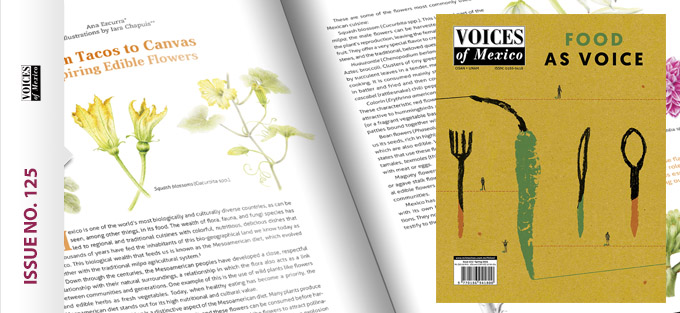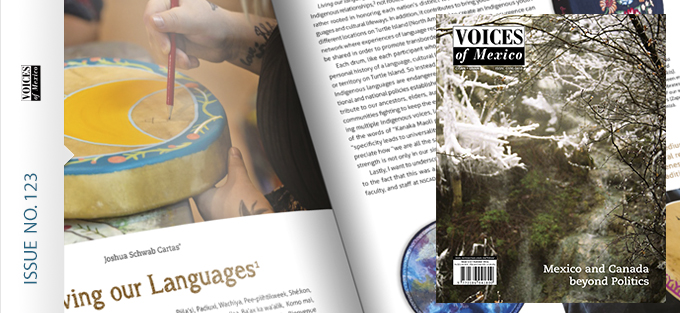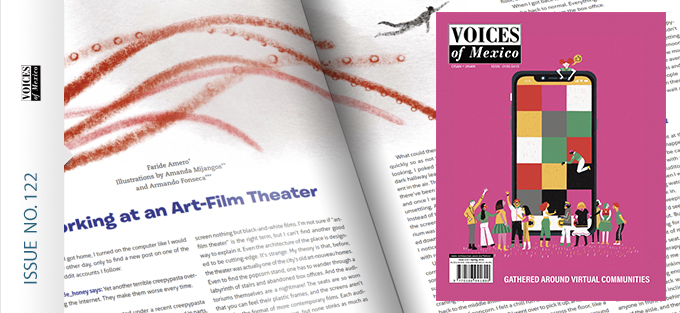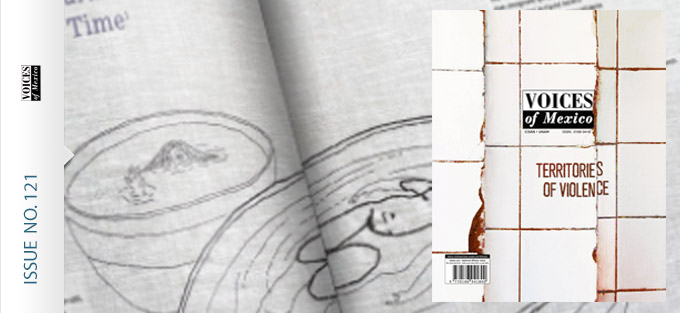In this Issue of Voices of Mexico
Content
Our Voice
Food as Voice
Food: Identity
César Silva Márquez
Food is the eyes to the soul. And if those eyes are served steamed with salt and laurel leaves, accompanied by coriander, lime, and salsa on a tortilla, they don’t only reflect who we are, but also where we come from. Food is the echo of our voice as a society, a living testament to our geography and history. Each dish, constructed over time and around the same rein- vented ingredients, clearly shows who we are, both as individuals and as a collective.
Culinary Discourse:
Nationalism vs. Violence
María Luisa Rentería
Introduction
Diet is one of the spheres that best shows us how a society operates and changes. That’s why a recipe book is always full of discourses. Nothing in cookbooks is superficial, gratuitous, or innocent. Studying them is like a compass, a time capsule that helps us identify ways the connections between people and the food they consume develop and understand cultural behavior. They are exercises in literary prose, and we can find in them not only guides about how to cook, but also a variety of socio-political and cultural discourses that show us an entire contextual analysis. For example, the first cookbooks in Mexi- co were written with nationalist aims at a time when people were seeking independence. Almost two centuries later, cook- books are being written to document acts of extreme violence, such as forced disappearance and gender-based violence.
Guiintabich: From Memory to Table
Daniela Sclavo Castillo
Lucía Pérez-Volkow
Emilio Hernández Martínez
Introduction
One June afternoon in 2021, over coffee and Mexican sweet bread, Doña Ernestina Santiago shared with her two daughters, Maggy and Liz, and with members of the Cocina Colaboratorio collective memories of her childhood. She particularly delved into how she had gained her enormous culinary knowledge of her community, Santo Domingo Tomaltepec, in the state of Oaxaca’s Central Valleys.
We all watched closely as she told us about the important role the women in her family had played, especially her mother and sister, in departing to her an infinite amount of knowledge, practices, and recipes that reflected the diversity of ingre- dients, crops, and plants from the lands where she grew up. Among her memories, Doña Ernestina recalled a kind of chili pepper called guiintabich, with a very special flavor that her mother used to cook with beans, but which stopped being consumed in the community forty or fifty years ago. What kind of chili pepper is guiintabich? Does it still exist? Why did people stop growing it, cooking it, and eating it?
The Mexican Food Entrepreneurs
and Workers Who Made New York
A More Exciting Place to Eat
Lori Flores
“Amigos: The city is gripped by Mexican madness. Never before has there been such passion for Mexican food, or so many places to enjoy it,” declared New York Magazine in 1983. On both a citywide and national scale, this fascination with Mexi- can food had taken time to develop. During the late nineteenth and early twentieth centuries, middle-class and elite diners in the United States and Mexico had circulated negative stereotypes of Mexican food as unhealthily spicy, the cuisine of poor indigenous peoples, or unhygienically prepared. During the mid-twentieth century, however, more US citizens were visiting Mexico for tourism and bringing home cravings for the cuisine. Mexican food eventually became part of the “TV dinner” revolution, with enchilada and taco kits and plates debuting in Texas and California and then spreading across the Southwest and Midwest by the early 1960s.
Does the Voice of Migrant Food Exist?
Laura Gabriela Linares Colmenares
Migration begins with the search for food.1 It is not the foundation of human existence: it is a response to the need to survive, to feed ourselves. Food in cities as we know them—with all the foods we might fancy available twenty-four hours a day, seven days a week—seems completely normal to us, but historically is anything but normal, since “for millions of years our forebears were in direct contact with the food they consumed, gathering wild plants and hunting wild animals, moving from place to place at nature’s pace, following the seasons and animal migrations.”2 As a result, migration was inextricably linked to our diet; it is a cornerstone of the human-food relationship.
Food as the Migrants’ Voice:
Mexicans’ Food Businesses
in the United States and Canada
Iliana Vázquez Zúñiga
Introduction
In migrant-receiving cities, food links the production of signifiers and consumption and socialization practices that allow migrants and their affiliation groups to construct a history for themselves and for others.1 As Manuel Calvo has written, immigrants in the process of establishing a new destination try to maintain eating habits from their places of origin, little by little combining new practices of sharing food together with the creation of a food system with new and old elements.
Free Trade Agreements, Biosecurity,
and Public Health: Maize and the
Transformations of Foodscapes
in Mexico, 1986-2024
Axel Elías Jiménez
“Today my Mexico is beautiful, as it never was, but when I was a child, my Mexico had a je ne sais quoi!” (Hoy mi México es bello, como nunca lo fue, pero cuando era niño, ¡tenía mi México un no sé qué!), wrote Chava Flores in his song Mi Méxi- co de ayer, in the mid-twentieth century. Yet, these lines have resonated constantly throughout my lifetime. During sev- eral strolls or bike rides, I have found myself thinking about how much the city has changed. In The Colossus of New York, Colson Whitehead reflected on how the constant transformation of tangible aspects of New York City (nyc), mainly its skyline and buildings, rendered it unrecognizable in the blink of an eye. Changes in Mexico City’s architectural landscape may not seem as fast paced as nyc’s, but as Chava Flores suggested, its intangible elements (both in Mexico City and in other cities) are ever changing. Through my personal experiences and memories around maize, I address how foodways in Mexico have been shaped by global trade and agro-industrial production, and the visible effects these forces have in our cur- rent everyday lives.
Raíces y Tránsito
Información para migrantes
Our Voice
Food as Voice
Culinary Heritage,
Contribution to Humanity
Enid Desiree Fuentes Romero
Food: Identity
César Silva Márquez
Culinary Discourse:
Nationalism vs. Violence
María Luisa Rentería
Urban Renewal and Cultures,
Strategies and Challenges
Alejandro Mercado-Celis
The Alamo Collection: A Testament to the
Rich History and Cultural Heritage of Texas
Ernesto Rodriguez
Education at the Alamo
Alex Rivard
Guiintabich: From Memory to Table
Daniela Sclavo Castillo
Lucía Pérez-Volkow
Emilio Hernández Martínez
The Mexican Food Entrepreneurs
And Workers Who Made New York
a More Exciting Place to Eat
Lori Flores
Does the Voice of Migrant Food Exist?
Laura Gabriela Linares Colmenares
Food as the Migrants’ Voice:
Mexicans’ Food Businesses
In the United States and Canada
Iliana Vázquez Zúñiga
Free Trade Agreements, Biosecurity,
And Public Health: Maize and the
Transformations of Foodscapes
In Mexico, 1986-2024
Axel Elías Jiménez
Voices on Food, Love and Miracles:
Overcoming Student
Malnourishment with Love
José Tenorio
Pulque, Beer, and Gender in Mexico
Jeffrey M. Pilcher
Voice of Mezcal, Voice of Mexico
Ronda L. Brulotte
Natural Wine in Mexico City: Cosmopolitan
Identities in The Urban Night
Yolanda Macías
Alejandro Mercado-Celis
Cooking Well-being amidst Aromas, Flavors,
Colors, and Textures: Cannabis Flowers
A Complex, Fascinating Ingredient
Aaraón Díaz Mendiburo
Yariela Carmona González
Women and Alcohol in
The Unnatural and Accidental Women
Claudia Lucotti
Mexican Chefs and Labor Justice
In the Seventh Season of Chef’s Table
Julieta Flores Jurado
Illustration by Elizabeth Flores Jurado
The Thin Line between Family
Inspiration and Culinary Authorship:
On the Series Aftertaste
Oswaldo A. Lara Orozco
Food as Voice, Song, and Sayings:
Hens, Chickens, and Turkeys
Lilia Martínez y Torres
More than Meals and Food Stalls:
unam Alumni on Food,
Memory and Connection
A Wandering Coffee Lover
Fer Andablo
Two Shops, One Market
Joaquín Guillén Márquez
At the Corner of Xicoténcatl
and Ignacio Allende
Karolina Ulloa
Art and Culture
Still Life with Winter and Fruit
Irene Artigas Albarelli
From Tacos to Canvas
Inspiring Edible Flowers
Ana Ezcurra
Illustrations by Iara Chapuis
13 Ways of Looking at a Meal
Adriana Toledano
Illustrations by Laura Castellanos
Food: Objective Correlative
Astrid Velasco
Directory
Director
Graciela Martínez-Zalce Sánchez
zalce@unam.mx
Coordinator of Publications
Astrid Velasco Montante
astridvm@unam.mx
Editor-in-Chief
Teresa Jiménez Andreu
tejian@unam.mx
About Us
Voices of Mexico is published by the Centro de Investigaciones sobre América del Norte, CISAN (Center for Research on North América) of the Universidad Nacional Autónoma de México UNAM (National Autonomous University of Mexico).
The magazine brings our readers information about different issues of general interest in Mexico, particularly regarding culture and the arts, the environment, and socio-economic development. It features critical articles and literature by Mexican authors in English and is distributed in Mexico, the United States, and Canada.
Contact
Address: Torre II de Humanidades, piso 9, Ciudad Universitaria, Coyoacán, 04510, México D.F.
Telephone: (52-55) 5623 0308
5623 02 81
Fax: (52-55) 5623 0308
Electronic mail: voicesmx@unam.mx





